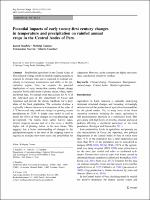Potential impacts of early twenty-first century changes in temperature and precipitation on rainfed annual crops in the Central Andes of Peru
Resumen
Smallholder agriculture in the Central Andes of Peru is based to large extent on rainfed cropping systems, is exposed to climatic risks and is expected to respond sensitively to increasing temperatures and shifts in the precipitation regime. Here, we examine the potential implications of early twenty-first century climate change scenarios for the cultivation of potato, maize, wheat, barley and broad bean, five annual crops that account for 50 % of the cultivated area in the Department of Cusco and
Apurı´mac and provide the dietary backbone for a large share of the local population. The scenarios disclose a regionally coherent increase in temperature of the order of 1 C but overall only moderate changes in growing season precipitation by 2030. A simple crop model is used to assess the effects of these changes on crop phenology and development. The results show earlier harvest dates,
shorter cropping seasons and, in a few cases, a slightly higher risk of planting failure in the near future. This suggests that a better understanding of changes in the precipitation regime at the onset of the cropping season is required to evaluate short-term needs and possibilities for adaptation. However, as the scenarios are highly uncertain, these conclusions should be verified.
El ítem tiene asociados los siguientes ficheros de licencia:








